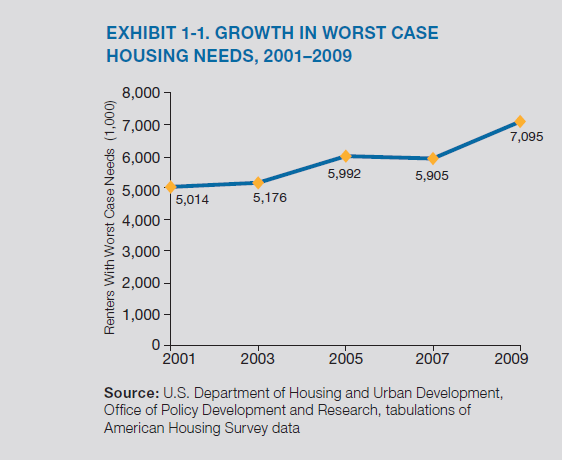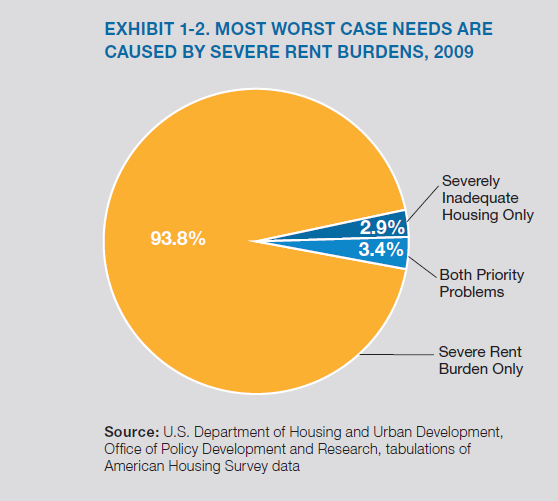Blog

Low Income Housing Needs Skyrocket. "Worst Case" Worsens
HUD’s definition of Worst Case Housing Needs (WCN): unassisted very low-income renters who either (1) pay more than one-half of their monthly income for rent; or (2) live in severely inadequate conditions, or both. HUD defines “very low-income” as below 50 percent of the local area median income (AMI) and “extremely low-income” as below 30 percent of AMI.</p
In its WorstrnCase Housing Needs report to Congress, the Department ofrnHousing and Urban Development said the number of people classified as “Worst Case” grew by nearly 1.2 millionrnhouseholds, or 20 percent, from 2007 to 2009 and 42 percent since 2001. The two-year increase was the worst in atrnleast 20 years.</p
 </p
</p
The report is based on further analysis of the American Housing Survey which is conducted every two years, mostrnrecently between May and September 2009. Not surprisingly, it found a direct link between the increasedrnnumber of Worst Case Needs and the recent recession and the high rate of joblessness in America. However, given those dates, it is obvious the data does not reflect the total impactrnof the recession or any effects of the Obama Administration’s recovery efforts.rnUnemployment and under-employment pushed 410,000 more households intornthe Worst Case Needs category, which accounts for more than one-third of all newrncases. </p
Dr. Raphael Bostic, HUD’s Assistant Secretaryrnfor Policy Development and Research saidrnin a press conference accompanying the release that severely inadequaternhousing, that which has one or more serious physical problems related to majorrnsystems or maintenance, has accounted for a declining number of Worst Case Needs and now represents only 2.9 percent. The majority of the 7.1 million worst case rentersrnare those with low incomes who lack any type of rental assistance and pay a burdensomernamount of rent.</p
Bostic, said, “The loss of income and the general lack of affordablernhousing are clearly putting a lot of stress on unassisted families at the lowerrnend of the income spectrum. It’s equally clear that had it not been forrnhousing assistance offered by HUD, the economic impact on very low-incomernrenters would have been greater still.”</p
 </p
</p
Worst Case Needs are broad-based in all demographics, cutting across regions, ethnicity,rnpopulation densities and household types. rnSome figures stand out such as an 8 percent jump in Worst Case Needsrnamong the Hispanic population where 45 percent of households fall into thatrncategory. White non-Hispanic households now account for nearly 48 percent ofrnworst cases, Black renters 23 percent, and Hispanic renters 23 percent. </p
Families with children represent 39 percent of cases and their numbersrngrew by 550,000 in two years. The secondrnhighest incidence, 33 percent, is among non family households, that is non-elderlyrnand unrelated persons who share a housing unit. rnNumbers in this category also grew by 580,000 households which mayrnindicate that households are doubling up in order to manage shrinking incomesrnand growing rents.</p
Persons with disabilities have a high presence among worst cases withrn38 percent reporting a non-elderly resident. rnThere is other evidence indicating that persons with disabilities arernbeing severely undercounted, perhaps by as much as 60 percent, and HUD plans tornlook further at this cohort.</p
The effects of un- and under-employment are exacerbated by a shortagernof affordable housing and this competition accounts for about 41 percent of thernincrease in worst cases. Competition leads to displacement, absorption of vacancies,rnand upward pressure on rents. Supply andrndemand led to increases in mean gross rent for very low-income renters of morernthan 10 percent in the two years and the number of vacant units affordable tornthis population dropped by 370,000. Only 32 units of housing are available forrnevery 100 extremely low income renters and 60 units for very low incomernrenters. The supply of housing is even more scarce in central cities and suburbs than in rural areas and in the West than in otherrnregions, but the numbers of affordable units is far from sufficient in anyrnregion. </p
Bostic said that the Worst Case numbers would have been much worse werernit not for the 4.4 million households that receive some type of rentalrnassistance but the resources available can’t cover the numbers of people whornneed it. While this has always been arnproblem, he said, currently many areas have waiting lists for assistance thatrnstretch into multiple years.</p
There are ongoing conversations with Congress about increasingrnassistance but Bostic said until this report was complete HUD did not know thernextent of the current problem. He hopesrnthat the report will form a base for further discussions even in light of thernfiscal realities. </p
READ MORE: Time For A Serious Look At Housing Problems And Policy
All Content Copyright © 2003 – 2009 Brown House Media, Inc. All Rights Reserved.nReproduction in any form without permission of MortgageNewsDaily.com is prohibited.
Latest Articles
By John Gittelsohn August 24, 2020, 4:00 AM PDT Some of the largest real estate investors are walking away from Read More...
Late-Stage Delinquencies are SurgingAug 21 2020, 11:59AM Like the report from Black Knight earlier today, the second quarter National Delinquency Survey from the Read More...
Published by the Federal Reserve Bank of San FranciscoIt was recently published by the Federal Reserve Bank of San Francisco, which is about as official as you can Read More...

Comments
Leave a Comment